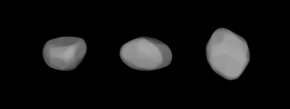
Back 208 لكريمسا Arabic لكريمسا 208 ARZ 208 Lacrimosa AST (208) Лакрымоза Byelorussian (208) Lacrimosa Catalan (208) Лакримоза CE (208) Lacrimosa German 208 Λακριμόζα Greek 208 Lacrimosa Esperanto (208) Lacrimosa Spanish
 A three-dimensional model of 208 Lacrimosa based on its light curve. | |
| Discovery | |
|---|---|
| Discovered by | Johann Palisa |
| Discovery date | 21 October 1879 |
| Designations | |
| (208) Lacrimosa | |
| Pronunciation | /lækrɪˈmoʊsə/ |
Named after | Our Lady of Sorrows (lacrimōsa) |
| A879 UB | |
| Main belt (Koronis) | |
| Orbital characteristics[1] | |
| Epoch 31 July 2016 (JD 2457600.5) | |
| Uncertainty parameter 0 | |
| Observation arc | 115.12 yr (42,049 d) |
| Aphelion | 2.9309 AU (438.46 Gm) |
| Perihelion | 2.85551 AU (427.178 Gm) |
| 2.89320 AU (432.817 Gm) | |
| Eccentricity | 0.013028 |
| 4.92 yr (1,797.5 d) | |
Average orbital speed | 17.51 km/s |
| 209.78° | |
| 0° 12m 1.008s / day | |
| Inclination | 1.7458° |
| 4.2626° | |
| 108.363° | |
| Physical characteristics | |
| Dimensions | 41.33±1.7 km |
| 14.085734 h (0.5869056 d)[2] | |
| 0.2696±0.023 | |
| S | |
| 8.96 | |
208 Lacrimosa is a main-belt asteroid that was discovered by Austrian astronomer Johann Palisa on 21 October 1879 in Pola. The name derives from Our Lady of Sorrows, a title given to Mary, the mother of Jesus. It is orbiting the Sun at a distance of 2.89320 AU with a period of 4.92 yr and an eccentricity (ovalness) of 0.013. The orbital plane is inclined at an angle of 1.7° to the plane of the ecliptic.[1]
During 2003, the asteroid was observed occulting a star. The resulting chords provided a cross-section diameter estimate of 44.3 km.[3] 10μ radiometric data collected from Kitt Peak in 1975 gave a diameter estimate of 42 km for this asteroid.[4] It is classified as an S-type asteroid and is one of the largest members of the Koronis asteroid family.[5] Hence it is probably a piece of the original asteroid that was shattered in an ancient impact that created the family.
- ^ a b Cite error: The named reference
JPLwas invoked but never defined (see the help page). - ^ Cite error: The named reference
Vokrouhlický_et_al_2021was invoked but never defined (see the help page). - ^ Cite error: The named reference
Shevchenko_Tedesco_2006was invoked but never defined (see the help page). - ^ Cite error: The named reference
Morrison1976was invoked but never defined (see the help page). - ^ Cite error: The named reference
Moore2011was invoked but never defined (see the help page).